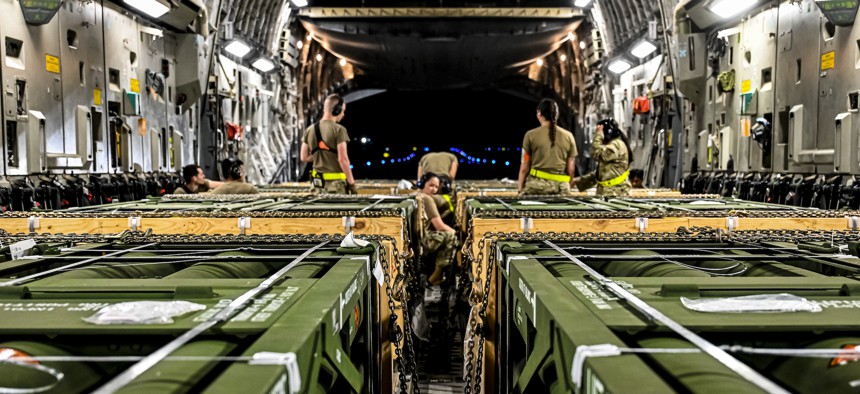
Airmen load Guided Multiple Launch Rocket System munitions onboard a Boeing 767 at Joint Base McGuire-Dix-Lakehurst, N.J., Aug. 13, 2022. Senior Airman Matt Porter
Army Wants to Double Or Triple Some Arms Production As Ukraine War Continues
GMLRS, HIMARS, and artillery rounds top the list.
Army leaders are working to dramatically increase the production of critical munitions and equipment drained from service arsenals to aid Ukraine in recent months.
With Congress’ support, they are working to triple domestic production of the 155mm howitzer rounds and at least double production of Guided Multiple Launch Rocket Systems and High Mobility Artillery Rocket Systems launchers in the next few years, said Doug Bush, the Army’s acquisition chief.
“All that is underway and will all be foundational to supporting Ukraine and its conflict, but also replenishing ourselves and setting us up to support our allies,” Bush told reporters Wednesday.
Ukrainians have been fighting the Russian invasion of their country for six months and their successful counteroffensive in the northeast recently has analysts in Europe calling for more support through weapons and aid. The Army has responded to the demand for weapons, Bush said, and is preparing to support the war effort into the future.
“I don't know how long the conflict’s going to last,” he said. “We are doing things though to ensure that if it goes on a long time, we're going to be in a place to support it based on the best information we have. War as an uncertain enterprise.”
Bush said it usually takes several months to a year to ramp up the production of something like a HIMARS from a rate of five per month to eight, which is why Army leaders are working closely with defense contractors. However, more production also means other problems to overcome.
“There are sometimes limitations, physical limitations, where you can fill a factory, get it up to a production rate and then if you want to go higher you're building another factory, or you're finding another company to do the same thing somewhere else, which is also not overnight,” he said. “So I'd say these goals are more in the high number of months to a year to try to get these increased production rates fully manifested.”
As of Sept. 8, the U.S. has sent 807,000 155mm rounds to Ukraine. An anonymous defense official told the Wall Street Journal last month that U.S. stocks are now “uncomfortably low.”
Bush dismissed the official’s characterization of the stocks, saying that only Army leaders should be making those judgements. He added that the service is still making and stockpiling enough for normal training and missions.
Bush did say that restocking the rounds is getting “the biggest attention right now.”
The 155mm rounds are “the thing that we're expending the most effort on, and [that] we've gotten tremendous support from Congress on, because of the lead times and the necessity to dramatically increase those production rates,” he said.
Other top priorities are GMLRS, anti-tank Javelin missiles, and Stinger missiles, that latter of which Bush said is “well under control now.”
The U.S. has sent “thousands” of GMLRS rounds to Ukraine, Gen. Mark Milley, the chairman of the Joint Chiefs of Staff, said last week.
It has also sent more than 8,500 Javelins. Congress has since provided the military over $1 billion to replace the missiles. On Tuesday, the Army ordered more than 1,800 Javelins for delivery by Nov. 30, 2026, under a $311 million contract to Raytheon and Lockheed Martin’s Javelin Joint Venture. More than 1,800 of those will replenish U.S. stocks, but the contract also covers an unspecified number of Javelin systems and production support for the U.S. Army and international customers Lithuania and Jordan.
Bush said their goal is to obligate all the money for Javelin production by the end of the 2023 fiscal year.
The Pentagon is working with allied countries to also produce more of these munitions as well as encourage them to donate to Ukraine to relieve some of the pressure on the U.S., Bush said.




